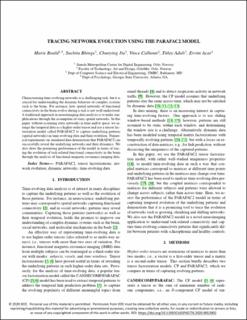Tracing Network Evolution Using The PARAFAC2 Model
Peer reviewed, Journal article
Accepted version
Permanent lenke
https://hdl.handle.net/11250/3046769Utgivelsesdato
2020-04-09Metadata
Vis full innførselSamlinger
Originalversjon
https://doi.org/10.1109/ICASSP40776.2020.9053902Sammendrag
Characterizing time-evolving networks is a challenging task, but it is crucial for understanding the dynamic behavior of complex systems such as the brain. For instance, how spatial networks of functional connectivity in the brain evolve during a task is not well-understood. A traditional approach in neuroimaging data analysis is to make simplifications through the assumption of static spatial networks. In this paper, without assuming static networks in time and/or space, we arrange the temporal data as a higher-order tensor and use a tensor factorization model called PARAFAC2 to capture underlying patterns (spatial networks) in time-evolving data and their evolution. Numerical experiments on simulated data demonstrate that PARAFAC2 can successfully reveal the underlying networks and their dynamics. We also show the promising performance of the model in terms of tracing the evolution of task-related functional connectivity in the brain through the analysis of functional magnetic resonance imaging data.
